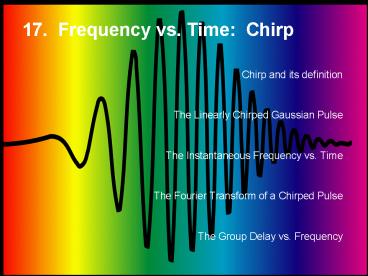17' Frequency vs' Time: Chirp - PowerPoint PPT Presentation
1 / 13
Title:
17' Frequency vs' Time: Chirp
Description:
... Instantaneous Frequency vs. Time. The ... The temporal phase, (t), contains frequency-vs.-time information. ... The Group Delay vs. w for a Chirped Pulse ... – PowerPoint PPT presentation
Number of Views:364
Avg rating:3.0/5.0
Title: 17' Frequency vs' Time: Chirp
1
17. Frequency vs. Time Chirp
- Chirp and its definition
- The Linearly Chirped Gaussian Pulse
- The Instantaneous Frequency vs. Time
- The Fourier Transform of a Chirped Pulse
- The Group Delay vs. Frequency
2
A light wave has intensity and phase vs. time.
Neglecting the spatial dependence for now, the
pulse electric field is given by
Intensity
Phase
Carrier frequency
The phase tells us the color evolution of the
pulse in time.
3
The Instantaneous frequency
The temporal phase, ?(t), contains
frequency-vs.-time information. The pulse
instantaneous angular frequency, ?inst(t), is
defined as
This is easy to see. At some time, t, consider
the total phase of the wave. Call this quantity?
?0 Exactly one period, T, later, the total
phase will (by definition) increase to ?0 2p
where ?(tT) is the slowly varying phase at
the time, tT. Subtracting these two equations
4
Instantaneous frequency (contd)
Dividing by T and recognizing that 2p/T is a
frequency, call it ?inst(t) ?inst(t) 2p/T
?0 ?(tT) ?(t) / T But T is small, so
?(tT)?(t) /T is the derivative, d? /dt. So
were done! Usually, however, well think in
terms of the instantaneous frequency, ?inst(t),
so well need to divide by 2? ?inst(t)
?0 d??/dt / 2? While the instantaneous
frequency isnt always a rigorous quantity, its
fine for most cases, especially for waves with
broad bandwidths.
5
The Chirped Pulse
- A pulse can have a frequency that varies in time.
This pulse increases its frequency linearly in
time (from red to blue). In analogy to bird
sounds, this pulse is called a "chirped" pulse.
6
The Chirped Pulse(continued)
- We can write a linearly chirped Gaussian pulse
mathematically as
Chirp
Gaussian amplitude
Carrier wave
Note that for b gt 0, when t lt 0, the two terms
partially cancel, so the phase changes slowly
with time (so the frequency is low). And when t gt
0, the terms add, and the phase changes more
rapidly (so the frequency is larger)
7
The Instantaneous Frequencyvs. time for a
Chirped Pulse
- A chirped pulse has
- where
- The instantaneous frequency is
- which is
- So the frequency increases linearly with time.
- More complex phases yield more complex
frequencies vs. time.
8
The Negatively Chirped Pulse
- We have been considering a pulse whose frequency
increases - linearly with time a positively chirped pulse.
- One can also have a negatively
- chirped (Gaussian) pulse, whose
- instantaneous frequency
- decreases with time.
- We simply allow b to be negative
- in the expression for the pulse
- And the instantaneous frequency will decrease
with time
9
Nonlinearly Chirped Pulses
- The frequency of a light wave can also vary
nonlinearly with time. - This is the electric field of aGaussian pulse
whose frequency varies quadratically with time - This light wave has the expression
- Arbitrarily complex frequency-vs.-time behavior
is possible.
10
The Fourier Transformof a Chirped Pulse
- Writing a linearly chirped Gaussian pulse as
- or
- Fourier-Transforming yields
- Rationalizing the denominator and separating the
real and imag parts
A Gaussian with a complex width!
A chirped Gaussian pulse Fourier-Transforms to
itself!!!
11
The Group Delay vs. Frequency
- The frequency-domain quantity that is analogous
to the - instantaneous frequency vs. t is the "group
delay" vs. w. - If the wave in the frequency domain is
- then the group delay is the derivative of the
spectral phase - The group delay is also not always the actual
delay of a given - frequency. It is only an approximate quantity.
12
The Group Delay vs. w for a Chirped Pulse
- The group delay of a wave is the derivative of
the spectral phase - For a linearly chirped Gaussian pulse, the
spectral phase is - So
- And the delay vs. frequency is also linear.
- When the pulse is long (a 0), then
- which is just the inverse of the instantaneous
frequency vs. time.
13
Spectral-Phase Taylor Series
- It is common practice to expand the spectral
phase in a Taylor Series
What do these terms mean? ?0 Absolute
phase ?1 Delay ?2 Quadratic phase, i.e.,
linear chirp ?3 Cubic phase, i.e., quadratic
chirp































